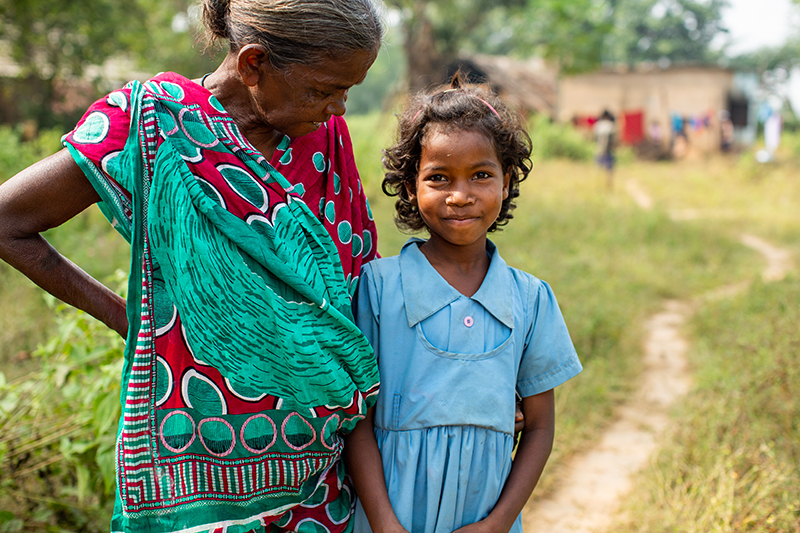Site will be
unavailable for maintenance from June. 4, 11:30 p.m., to June 5, 12:30 a.m. ET. Thank you for your
patience!
The ripple effect: How sponsorship helps families and communities
Posted on 02/05/2021
When Judith, 11, first got a sponsor at age 2, her family never imagined how it would change their lives – or their entire town, a rural area in the Andean foothills of Cochabamba, Bolivia. “We’re farmers,” says her dad, Fostin. “During the winter months, we can’t grow anything, or sometimes in summer it gets too dry.” But since ChildFund came to town, a sense of hope has pervaded the crisp mountain air. The whole community is more focused on the kids, coming together on a regular basis to learn about things like child nutrition, violence prevention and the importance of education. Letters and gifts from sponsors punctuate the rhythms of farm life with an added layer of joy – and financial security. “Judith’s sponsor gets us through the hard times,” Fostin says.
Thank you for your care, your support and your continued hope. Your kindness is the driving force behind every single thing we’re able to do for children, during this crisis and always.
What’s happening in Judith’s community isn’t unusual. It’s par for the course of sponsorship, which impacts not only children but their families and communities, too. We like to call it “the ripple effect” – and it’s more powerful than you might imagine.
How Sponsorship Works
So how exactly does one child sponsorship ripple outward to make life better for a child’s family and community? The answer is all in how sponsorship works.

Sponsored child Jhosemarin, 9 (center, in pink stripes), stands with her family in Cochabamba, Bolivia. Before ChildFund began working in their community, many families in the area felt the need to keep their children home from school to help on their farms. Now, Jhosemarin’s parents understand the importance of education and send their children to school every day.
ChildFund is a community development organization. In other words, we help children by working within families and communities. No kid is an island, after all, and we believe that each child’s well-being is intimately connected to the well-being of the environment that shapes them. For example, if their parents lack a basic understanding of nutrition, a child will not have the healthy food they need to grow up strong. If their community follows a traditional practice of child marriage, a child will be at greater risk of dropping out of school, continuing the cycle of poverty into the next generation.
When you become a sponsor, your monthly donations are pooled with those from other sponsors to make life better in your sponsored child’s community. This means that although you exchange letters and gifts with just one child, your sponsorship actually benefits all the children in that community. For example, sponsorship funds might be used to build a well in a community where there is no clean water, create an emergency feeding program where children are struggling with malnutrition, or renovate a school or train teachers in a community where many children have dropped out due to the poor quality of education. And because local people know their own communities best, ChildFund always works through local partner organizations, using their knowledge to determine and then meet children’s most urgent needs.
But as much as sponsorship impacts community development, the sponsorship experience is still very much a personal one for a child and everyone in their household. When a child gets a sponsor, their family becomes part of the larger ChildFund family. They receive regular home visits from the staff of our local partner organization to check in on how they’re doing – is everyone getting enough to eat? Is anyone sick? Are the children going to school? Almost overnight, a sponsored child has a safety net of support so that when the family falls on “hard times,” as Fostin says, they don’t have to worry about how they will survive.
Help Families in Poverty - though Sponsorship
Through their gifts and letters, sponsors have the opportunity to make a direct impact on a child’s family and community. Fueled by sponsors’ words of encouragement, sponsored children often grow up to become compassionate adults who care deeply for their communities, paying the kindness forward.
When the COVID-19 pandemic hit in 23-year-old Rafael’s community in Bolivia, he watched in horror as, one by one, families placed white flags in their doorways to signify hunger. “I knew I had to do something,” he says. So he began collecting food from around his community and delivering it to families in need himself.
“When I was little, many times I went through that situation of not having anything to eat,” Rafael says. Then he got a sponsor. “When my situation was really critical as a child, my sponsor supported me, even with her letters, cards, everything,” he says. “I believe she also inspired me to help these families.”
Rafael’s story illustrates how, when we support just one child, immense change is possible for everyone. And isn’t that what community is all about, anyway – growing together? Sponsor a child right now to join ours and make ripples for generations to come..

Jhunu, 8, with her grandmother in Keonjhar District, India. Jhunu is not a sponsored child, but her sister is – and her whole family reaps the benefits.
Loading...


